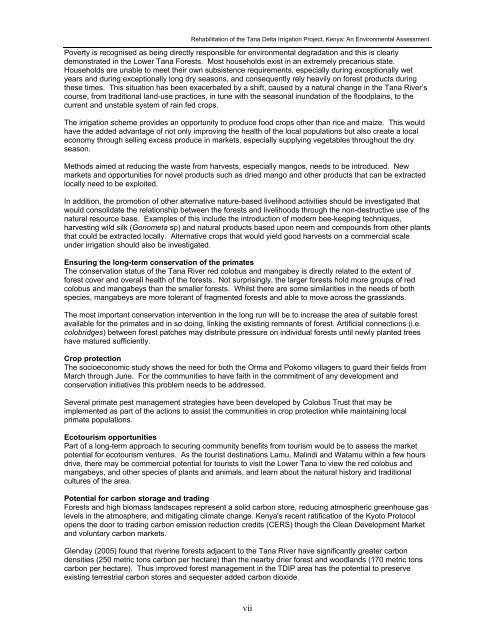Tana Delta Irrigation Project, Kenya: An Environmental Assessment
Tana Delta Irrigation Project, Kenya: An Environmental Assessment
Tana Delta Irrigation Project, Kenya: An Environmental Assessment
Create successful ePaper yourself
Turn your PDF publications into a flip-book with our unique Google optimized e-Paper software.
Rehabilitation of the <strong>Tana</strong> <strong>Delta</strong> <strong>Irrigation</strong> <strong>Project</strong>, <strong>Kenya</strong>: <strong>An</strong> <strong>Environmental</strong> <strong>Assessment</strong>.<br />
Poverty is recognised as being directly responsible for environmental degradation and this is clearly<br />
demonstrated in the Lower <strong>Tana</strong> Forests. Most households exist in an extremely precarious state.<br />
Households are unable to meet their own subsistence requirements, especially during exceptionally wet<br />
years and during exceptionally long dry seasons, and consequently rely heavily on forest products during<br />
these times. This situation has been exacerbated by a shift, caused by a natural change in the <strong>Tana</strong> River’s<br />
course, from traditional land-use practices, in tune with the seasonal inundation of the floodplains, to the<br />
current and unstable system of rain fed crops.<br />
The irrigation scheme provides an opportunity to produce food crops other than rice and maize. This would<br />
have the added advantage of not only improving the health of the local populations but also create a local<br />
economy through selling excess produce in markets, especially supplying vegetables throughout the dry<br />
season.<br />
Methods aimed at reducing the waste from harvests, especially mangos, needs to be introduced. New<br />
markets and opportunities for novel products such as dried mango and other products that can be extracted<br />
locally need to be exploited.<br />
In addition, the promotion of other alternative nature-based livelihood activities should be investigated that<br />
would consolidate the relationship between the forests and livelihoods through the non-destructive use of the<br />
natural resource base. Examples of this include the introduction of modern bee-keeping techniques,<br />
harvesting wild silk (Gonometa sp) and natural products based upon neem and compounds from other plants<br />
that could be extracted locally. Alternative crops that would yield good harvests on a commercial scale<br />
under irrigation should also be investigated.<br />
Ensuring the long-term conservation of the primates<br />
The conservation status of the <strong>Tana</strong> River red colobus and mangabey is directly related to the extent of<br />
forest cover and overall health of the forests. Not surprisingly, the larger forests hold more groups of red<br />
colobus and mangabeys than the smaller forests. Whilst there are some similarities in the needs of both<br />
species, mangabeys are more tolerant of fragmented forests and able to move across the grasslands.<br />
The most important conservation intervention in the long run will be to increase the area of suitable forest<br />
available for the primates and in so doing, linking the existing remnants of forest. Artificial connections (i.e.<br />
colobridges) between forest patches may distribute pressure on individual forests until newly planted trees<br />
have matured sufficiently.<br />
Crop protection<br />
The socioeconomic study shows the need for both the Orma and Pokomo villagers to guard their fields from<br />
March through June. For the communities to have faith in the commitment of any development and<br />
conservation initiatives this problem needs to be addressed.<br />
Several primate pest management strategies have been developed by Colobus Trust that may be<br />
implemented as part of the actions to assist the communities in crop protection while maintaining local<br />
primate populations.<br />
Ecotourism opportunities<br />
Part of a long-term approach to securing community benefits from tourism would be to assess the market<br />
potential for ecotourism ventures. As the tourist destinations Lamu, Malindi and Watamu within a few hours<br />
drive, there may be commercial potential for tourists to visit the Lower <strong>Tana</strong> to view the red colobus and<br />
mangabeys, and other species of plants and animals, and learn about the natural history and traditional<br />
cultures of the area.<br />
Potential for carbon storage and trading<br />
Forests and high biomass landscapes represent a solid carbon store, reducing atmospheric greenhouse gas<br />
levels in the atmosphere, and mitigating climate change. <strong>Kenya</strong>'s recent ratification of the Kyoto Protocol<br />
opens the door to trading carbon emission reduction credits (CERS) though the Clean Development Market<br />
and voluntary carbon markets.<br />
Glenday (2005) found that riverine forests adjacent to the <strong>Tana</strong> River have significantly greater carbon<br />
densities (250 metric tons carbon per hectare) than the nearby drier forest and woodlands (170 metric tons<br />
carbon per hectare). Thus improved forest management in the TDIP area has the potential to preserve<br />
existing terrestrial carbon stores and sequester added carbon dioxide.<br />
vii

















